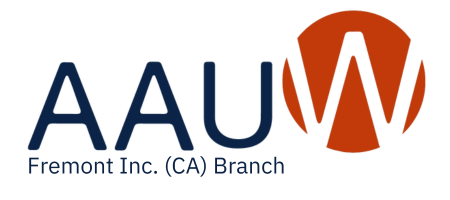The American Association of University Women, Fremont, California
Fremont Branch’s One Book, One Community Organization Proudly Presents
An Event Centered on the Human Trafficking Issue

Here are the presenters for a very successful and mind-blowing program: (left to right) AAUW’s Kris Sandoe and Margery Leonard, Sister Carrita Foster and Peter Lee of the FBI.
“Slavery,” said Sister Caritas Foster, “is woven into the very fabric of our lives.”
Sister Caritas is talking at this year’s first AAUW Fremont Branch One Book, One Community event at the Fremont Main Library on Saturday, October 12th.
She is a member of the Sisters of the Holy Family in Fremont and she means these words both literally and figuratively: literally because one of the industries that capture and force men, women and children to work under inhuman conditions is the clothing industry; and figuratively because human trafficking — a synonym for slavery — does not exist in some far off country or place, it is both a worldwide and a local phenomenon.
Sister Caritas, who works with victims of human trafficking on a daily basis, presented a grim picture of slavery in the 21st century. She passed along a potpourri of information about the subject in what she called Human Trafficking 101. Here are some of the sad truths:
- $20.9M people are enslaved globally according to the UN’s International Labor Organization. 15.4M are adults; 4.4M are children; 11.4M are women and girls and 1.5M are boys.
- Money is what makes human trafficking so enticing to criminals. There is a huge amount of profit in owning a human being. Slavery is the fastest growing criminal activity second only to the drug trade yet penalties for the crime are less onerous than for drugs.
- Detection is difficult because it’s a hidden crime and difficult to uncover and prosecute.
- The root cause of human trafficking is poverty. Because of poverty, people will sell themselves or their children to bring in some money to exist.
- Criminals pay a little money to harvest organs and turn around and make huge profits by selling them to developed countries.
- Slavery exists in several industries: fishing, domestic work and most prominently, the sex trade. It’s terrifying to learn that children are taken as young as two-years-old for the sex trade.
- The average age of enslaved prostitutes in our country is 12 and life expectancy of a prostitute once “recruited” is seven years.

This is a cross-section of attendees at the firstHalf the Sky presentation at the library.
Peter, he said, it was part of the fabric of the Bay Area and that San Francisco is the 50th largest port for bringing in trafficked individuals. The FBI partners with local police and government agencies to find and prosecute traffickers.
“The constitution,” he said, “may have abolished slavery but it’s right here under our very noses and so secretive its hard to detect.”
He asked us to look for enslaved people in our environment. “They could be anywhere in beauty salons, as domestics or cutting our lawns. Please be vigilant and if you suspect call the hot line.” The number is: 888 3737.
The best way to catch these criminals, according to Lee, is through the victims. There are victim specialist task forces, like the kind Sister Caritas is involved in, that rescues victims and sets them on a stabilizing path.
“We all went away shocked and saddened,” said Genevieve Angelides, co-chair of the OBOC Read program, “but with greater knowledge of a crime that often goes unpunished. This kind of information is what AAUW Fremont Branch brings to the community.”
Other sessions that focus on the book Half the Sky by Nicholas D. Kristof and Sheryl WuDunn (husband and wife) will include a collaboration with a class at Mission High School, a speaker from the Half the Sky movement and a DVD documentary on the subject of what the authors call “Gendercide.” Watch for them.
